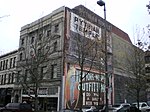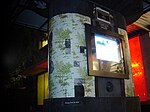Pantages Theater (Tacoma, Washington)
Buildings and structures completed in 1916Buildings and structures in Tacoma, WashingtonNational Register of Historic Places in Tacoma, WashingtonPerforming arts centers in Washington (state)Pierce County, Washington ... and 3 more
Theatres in Washington (state)Theatres on the National Register of Historic Places in Washington (state)Tourist attractions in Tacoma, Washington

The Pantages Theatre or Jones Building in Tacoma, Washington was designed by the architect B. Marcus Priteca. The unusual structure opened in January 1918. It was designed to be an office building and a vaudeville theatre. The theaters Second Renaissance Revival style is juxtaposed with the Commercial style. The exterior above the ground floor is largely unaltered. The building still houses entertainment and commercial activities (Tacoma City Theaters).
Excerpt from the Wikipedia article Pantages Theater (Tacoma, Washington) (License: CC BY-SA 3.0, Authors, Images).Pantages Theater (Tacoma, Washington)
South 9th Street, Tacoma
Geographical coordinates (GPS) Address Nearby Places Show on map
Geographical coordinates (GPS)
| Latitude | Longitude |
|---|---|
| N 47.255277777778 ° | E -122.43944444444 ° |
Address
D Town Market
South 9th Street
98405 Tacoma
Washington, United States
Open on Google Maps







